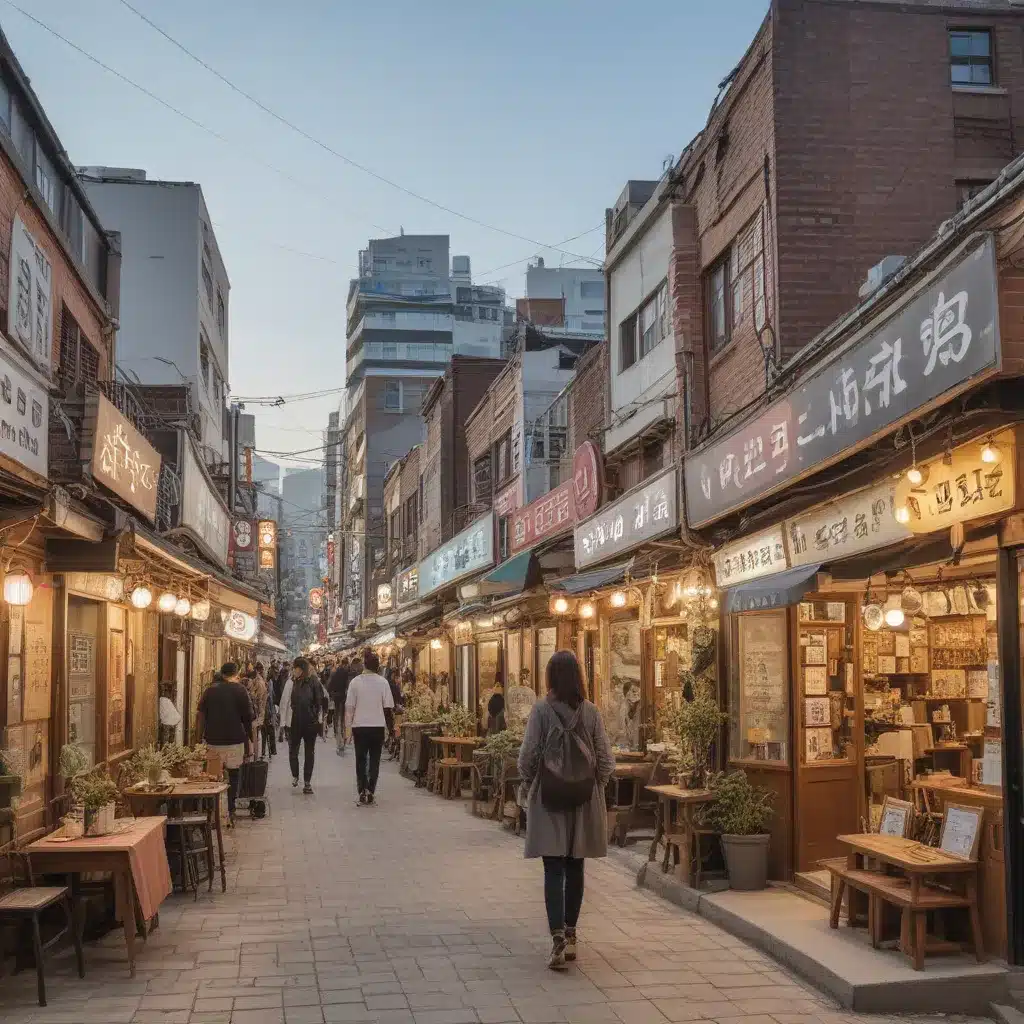
Discovering the Flavors and Traditions of Korea’s Capital
As I strolled through the bustling streets of Seoul, the vibrant energy of this dynamic city enveloped me. But it wasn’t just the towering skyscrapers and neon-lit billboards that captivated my senses – it was the tantalizing aromas wafting from the local restaurants and markets that truly piqued my curiosity. I had come to explore the heart of Korean culture, and I was determined to immerse myself in the quirky, yet enchanting, world of Seoul’s K-Style hub.
Uncovering the Secrets of Hansik
My journey began at the iconic Namdaemun Market, the oldest and largest traditional market in Korea. As I wandered through the maze of stalls, I was struck by the sheer variety of ginseng on display, each shop vying for attention with bold claims about its medicinal properties. It was here that I met Veronica Tae-Ahn Kang, the founder of Gastro Tour Seoul, who would be my guide through the culinary wonders of the city.
Veronica, a graduate of Switzerland’s Institut Hôtelier César Ritz and a Master of Tourism, is a passionate advocate for Korean cuisine, or hansik. She explained that this traditional fare dates back nearly 5,000 years, and it’s not just about the ingredients – it’s about the historical, cultural, nutritional, and philosophical background of the food.
As we navigated the bustling Kalguksu Alley, where Korean grandmas shouted over the din to sell their famous noodle soups, Veronica shared her insights. “Koreans view food as medicine,” she said, “that keeps one healthy and strong.” This philosophy was evident in the restaurant we visited, where owner and chef Kim Bong-Chan had prepared a delectable spread of plant-based dishes made from exclusive, high-quality ingredients.
Immersing Myself in the K-Style Hub
With our bellies full of healthy and flavorful fare, Veronica and I set out to explore the K-Style Hub, a high-tech Korean Cuisine Cultural Center in the heart of the city. Here, visitors can learn about the history and philosophy of hansik, as well as experience traditional and contemporary Korean cuisine through cooking classes and tasting sessions.
As we stepped inside, we were greeted by the soothing sounds of traditional music and the gentle glow of soft lighting. The Korean Food Exhibition Hall took us on a journey through the 24 traditional seasons of Korea, each with its own significance in terms of crops and seasonal foods. It was a mesmerizing display that left me in awe of the depth and richness of this ancient culinary tradition.
Next, we ventured into the Korean Food Experience Hall, an ultra-modern kitchen where I had the opportunity to participate in a cooking class. Under the guidance of expert instructors, I learned the art of preparing classic Korean dishes like bulgogi and ssam, as well as more intricate traditional fare like chiljeolpan and bibimbap. The hands-on experience not only taught me new culinary skills but also deepened my appreciation for the nuances of Korean cuisine.
As we explored the various halls and exhibits, I couldn’t help but be captivated by the seamless integration of the old and the new. The K-Style Hub was a true celebration of the country’s culinary heritage, blending traditional elements with modern technology and innovation.
Discovering the Gems of Tongin Market
With our culinary adventure at the K-Style Hub coming to an end, Veronica and I decided to venture out to the nearby Tongin Market. This bustling alley was a treasure trove of local eateries and specialty food stalls, each offering a unique taste of Korean culture.
One of the most popular snacks was the gireum tteokbokki, or pan-fried rice cakes, sold by a vendor who had been plying his trade for over 30 years. As I savored the crispy, chewy goodness, I couldn’t help but marvel at the dedication and passion that went into preserving these traditional delicacies.
Indulging in the Sweet Delights of Noshi’s Table
Our final stop on this culinary journey was Noshi’s Table, a quaint dessert haven just a few blocks from Tongin Market. Here, we were treated to a modern take on traditional Korean sweets, with a menu that boasted an array of cold and warm desserts.
As I sank my spoon into the warm red bean cream with cinnamon, I was struck by the perfect balance of flavors and textures. The rice cakes, served with a scoop of ice cream, were a revelation, blending the familiar with the unexpected in a delightful dance on my palate.
Reflecting on the Richness of Korean Culture
As I bid farewell to the charming streets of Seoul, I couldn’t help but feel a sense of wonder and appreciation for the vibrant culinary scene I had experienced. From the centuries-old traditions of hansik to the creative fusion of old and new at the K-Style Hub, I had gained a deeper understanding of the depth and diversity of Korean culture.
This trip had not only satisfied my palate but had also ignited a newfound passion for exploring the quirky and captivating aspects of Seoul. And I know that whenever I return to the Hotel Stay Inn Seoul, I’ll be eagerly anticipating the next culinary adventure that awaits me in this enchanting city.

